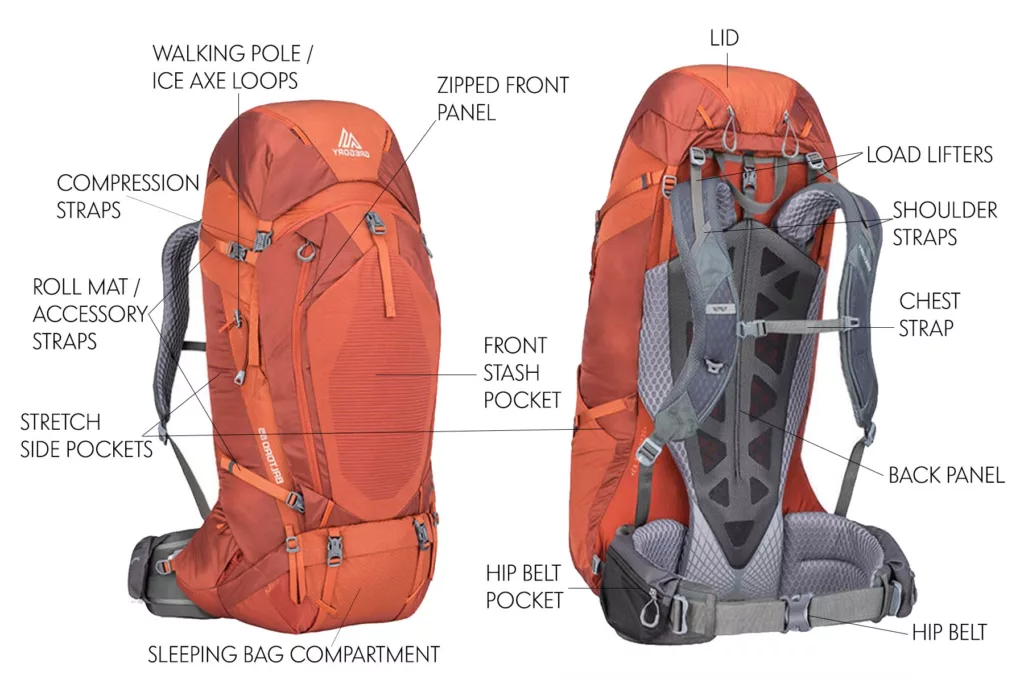Mastering the Art of Efficient Backpack Packing for Hiking Adventures
Embarking on a hiking expedition is not just about having the right gear; it’s also about knowing how to pack that gear efficiently. Properly loading your backpack is essential for enhancing your hiking experience, ensuring efficiency, convenience, and comfort throughout your journey. Let’s delve into the intricacies of backpack packing to optimize your next outdoor adventure.

Different Pockets on Backpack: A well-designed backpack is equipped with various compartments and pockets, each serving a specific purpose:
- “Brain” Pocket: This top pocket is perfect for storing compact, frequently used items such as snacks, navigation tools, and headlamps. Easy accessibility to these essentials can save time and hassle on the trail.
- Front Pouch or “Kangaroo Pouch”: Positioned for instant access, this pouch is ideal for storing items like rain jackets, keeping them within reach without the need to unpack your entire bag.
- Hip Belt Pocket: Strategically located on the hip belt, this pocket is reserved for high-use items like trail snacks and lip balm, allowing quick and convenient access without interrupting your stride.
- Water Bottle Pockets: These pockets are designed to securely hold water bottles, ensuring hydration is readily available during your hike.
Straps on Backpack: The straps on your backpack serve a crucial role in maintaining stability and comfort while on the move:
- Compression Straps: These straps help compress your gear inwards, keeping the weight close to your body and maintaining a tight center of gravity, which is essential for balance, especially on challenging terrain.
- Semi-Secret Zippers: Some backpacks feature semi-secret zippers that provide easier access to certain compartments, allowing you to quickly retrieve or store items without struggling with cumbersome closures.
- Sleeping Bag Compartment: Many backpacks include a dedicated sleeping bag compartment with a trap door for easy access, streamlining the process of setting up camp at the end of a long day.

Avoid Overpacking: One common pitfall for backpackers is overpacking, which can lead to unnecessary strain and discomfort on the trail:
- Tips for Over packers: Exercise restraint by distinguishing between essential and luxury items. Prioritize lightweight, multi-purpose gear and consider the importance of each item before adding it to your pack.
- Weight Reduction Exercise: Challenge yourself to reduce pack weight by critically evaluating each item’s necessity. Remember, every ounce adds up over the miles.
Packing the Backpack: When loading your backpack, prioritize comfort and convenience to optimize your hiking experience:
- Weight Distribution: Place the heaviest, densest gear closest to your back to maintain balance and stability. Lighter items should be positioned towards the outside to prevent shifting and maintain agility.
- Layering Strategy: Organize your gear based on frequency of use, with essential items easily accessible at the top or in designated pockets. This ensures you can retrieve necessities without rummaging through your entire pack.
Compression Sacks: Utilize compression sacks to streamline packing and protect your gear from the elements:
- Benefits: Compression sacks remove excess air, compacting your gear to save space and keep it organized. They also provide waterproofing for added protection during inclement weather.
- Drawbacks: Long-term compression can degrade certain materials, so be mindful of over-packing and consider the longevity of your gear.
Preparing for Rain: Don’t let unexpected showers dampen your spirits. Prepare for rain by implementing waterproofing strategies:
- Backpack Rain Cover: Invest in a waterproof cover specifically designed for your backpack to shield it from rain and moisture.
- Compression Sacks: Opt for waterproof compression sacks to protect sensitive gear from water damage.
- Trash Bags: In a pinch, use trash bags to line the interior of your backpack or to wrap individual items, such as your sleeping bag, for makeshift waterproofing.
Mastering the art of efficient backpack packing is a skill that can elevate your hiking adventures to new heights. By understanding the layout of your backpack, employing smart packing techniques, and preparing for the elements, you can embark on your next outdoor excursion with confidence and comfort. Happy trails!
** Here’s a little transparency. Our website contains affiliate links. This means if you click and purchase, we may receive a small commission. Don’t worry, there’s no extra cost to you. It is a simple way you can help support our mission to bring you quality content. **
(As an Amazon Associate, I earn from qualifying purchases)